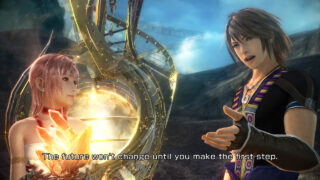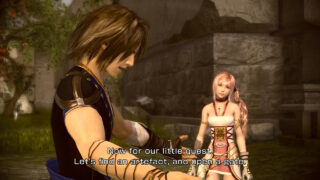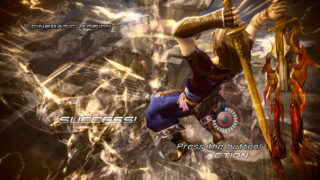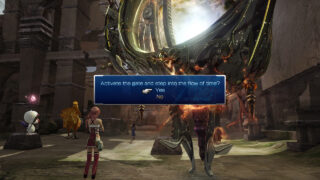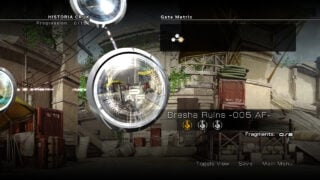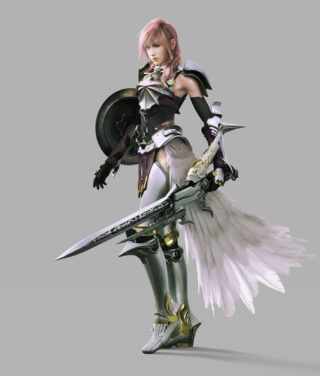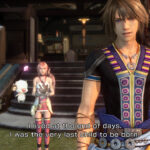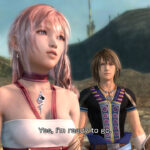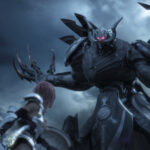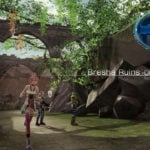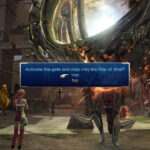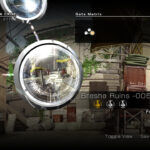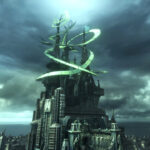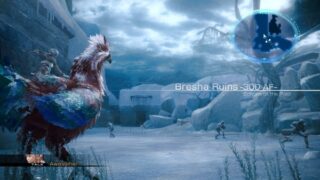
Square Enix released English details today surrounding Final Fantasy XIII-2‘s Historia Crux (known in Japan as “Historiacross”) system and Lightning’s role in the game (vita Square Enix blog 1, 2, 3).
Historia Crux
Historia Crux allows players to travel to different locations and time periods, and is the “basis” of the Final Fantasy XIII-2‘s world navigation system. Artefacts (O-Parts in Japanese) hidden across the game world allow players to unlock specific gates, which will either transport Noel and Serah to a different location or to a different time period.
The course of the game and the items you receive will change depending on when you visit these areas. Players will have to perform certain actions in different time periods to change the future or past. According to game director Motomu Toriyama, it’s just one of the ways Square Enix is assessing a non-linear approach.
“The original game, Final Fantasy XIII, was primarily story driven and progressed in a very linear manner,” said Toryiama. “For the sequel, Final Fantasy XIII-2, we are going for a much more player driven concept, so this time around the gameplay and story itself will alter to fit the player’s choices. You will be able to freely come and go between all the areas; the game will provide not just simple environmental exploration, but also a multi-layered exploration of history through the Historia Crux.”
Player choice is a heavy variable with Historia Crux.
“The Historia Crux branches off into multiple different routes depending on the player’s choices. You will be able to take a detour into areas that have branched off of the route you have taken, perform side missions and turn back time in each of the areas to experiment with all possibilities. It is of course also possible to progress simply following the main story, like in the original Final Fantasy XIII. The flow of areas accessible via Historia Crux has been structured so that all of the player’s actions and decisions will influence the gameplay.
“Depending on the player’s actions, new turning points to new futures will appear in time, and these will certainly form the basis for the multiple endings.”
Toryiama believes the system makes for a great mix between Final Fantasy XIII‘s story-driven gameplay and the key concept of “player freedom.”
“In the original game, the sidequests were only unlocked in the second half of the story in Gran Pulse, but in the sequel we have put in many different sidequests right from the start. Due to the overwhelming demand from players of the original, we have also included many strong and colourful mini games, a tradition of the Final Fantasy series. You will be able to return to any of the times and places whenever you like from the Historia Crux, so it is completely up to the player in what way they choose to play these.”
Final Fantasy XIII-2 is set during the fall of cocoon. When time travelling, the “AF” acronym is used for times “After Fall.” And we assume “BF” will be used for “Before Fall.”
Noel Kreiss
Noel Kreiss, Final Fantasy XIII-2‘s new protagonist, is from a future time where’s the last remaining survivor of a race wiped out. To change the events of his unfortunate present, he travels back in time.
Noel meets Serah at the very beginning of Final Fantasy XIII-2, after a meteor lands near her and Team NORA’s home.
“Come with me across the boundaries of time”, Noel says. “Your sister is waiting”.
Lightning’s Role
If you haven’t completed Final Fantasy XIII-2, this section may contain spoilers.
At the end of Final Fantasy XIII, Lightning saves Serah from her crystallized state and saves the world. Since then, she’s left the world to become the protector of the Goddess Etro in Valhalla, “the land of Chaos.” When Lightning is unable to save Valhalla, she calls upon Noel for help.
Screenshots
View a new set of screenshots at the gallery.
slide 1 of 29
- ❮
- ❯
slide 1 to 5 of 29




